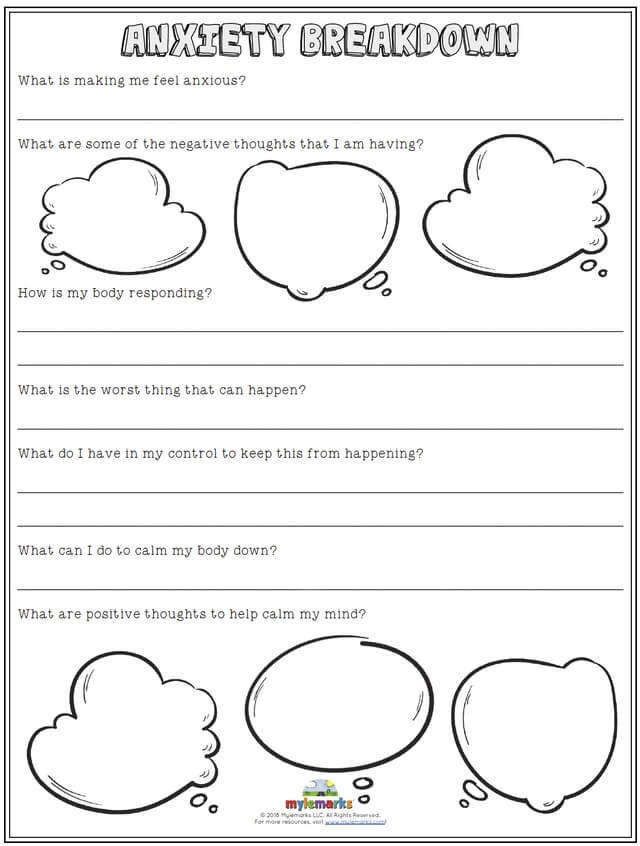5 Ways to Combat Teen Anxiety: Interactive Worksheet

In today's fast-paced world, teenagers are facing an unprecedented level of stress and anxiety, a matter of concern for parents, educators, and mental health professionals alike. Whether it's the pressure to excel academically, the complexities of social media, or personal struggles, teens often find themselves overwhelmed. But there's hope; understanding and implementing certain strategies can significantly help alleviate these feelings. This blog post delves into five practical, interactive ways to combat teen anxiety, providing both teens and their support systems with tools to navigate these turbulent years more smoothly.
1. Understanding Anxiety

Before we can tackle anxiety, we must first understand what it is. Anxiety can manifest in various forms, from social anxiety and panic attacks to generalized anxiety disorder. For teens, here are some common signs:
- Excessive worry or fear
- Difficulty concentrating
- Physical symptoms like headaches or stomachaches
- Avoidance of social situations
🔍 Note: Recognizing anxiety early can make a significant difference in managing it effectively.
2. Journaling for Emotional Release

One of the most therapeutic activities for any age group, including teenagers, is journaling. Here’s how to turn it into an interactive worksheet:
| Step | Activity |
|---|---|
| 1. | Create a daily mood log. Ask the teen to rate their anxiety level from 1 (no anxiety) to 10 (extreme anxiety). |
| 2. | Use prompts like “What was the best part of today?” or “What made you feel stressed or anxious today?” |
| 3. | Encourage creative expression through sketches or drawings alongside writing. |

📝 Note: Journaling not only helps in identifying patterns in anxiety but also in releasing pent-up emotions.
3. The 5-4-3-2-1 Grounding Technique

Grounding exercises are excellent for pulling someone out of an anxiety spiral. Here’s how to make it interactive:
- List five things you can see around you.
- Name four things you can touch, focusing on the texture.
- Identify three sounds you can hear in your environment.
- Recall two things you can smell, or if that’s not possible, two things you like to smell.
- Name one taste you can taste at the moment.
🌿 Note: This technique can be done anywhere and requires no special tools, making it a handy strategy during a moment of panic.
4. The Worry Jar

The Worry Jar concept turns abstract anxiety into something tangible that can be dealt with. Here’s how:
- Provide a jar and some paper strips.
- Have the teen write down their worries, fears, or thoughts on the strips.
- Encourage them to place these into the jar, symbolizing letting go of the worries for a time.
- Set a ‘Worry Time’ later in the day where they can address the worries one by one.
🗑️ Note: This technique helps teens compartmentalize their anxiety, making it less overwhelming.
5. Focused Breathing Exercises

When anxiety kicks in, our breathing often becomes shallow or erratic. Here’s an interactive way to practice mindful breathing:
- Breathing Ball Exercise: Teach them to inhale deeply while expanding a ball with their breath, then exhale to let the ball contract.
- Box Breathing: Have them visualize a box, inhaling for 4 seconds, holding for 4, exhaling for 4, and holding again for 4 seconds.
🧘 Note: Controlled breathing can reduce the ‘fight or flight’ response, helping to calm the mind.
Addressing teen anxiety requires patience, understanding, and the right tools. By engaging with these interactive exercises, teens can begin to develop coping mechanisms that not only help in the short term but foster a healthier approach to dealing with anxiety in the long run. The key is consistency and creating a supportive environment where open dialogue about mental health is encouraged.
How often should a teen practice these exercises?

+
Encouraging daily practice, especially during stressful times, can help teens manage anxiety more effectively. Even integrating these exercises once or twice a week can provide substantial benefits.
Can these techniques be used by adults?

+
Absolutely! These strategies are universally applicable and can be beneficial for managing anxiety at any age.
What if a teen is too anxious to engage in these activities?

+
Start slowly; even a short session of deep breathing or journaling a single thought can be a step in the right direction. If anxiety becomes unmanageable, consider seeking professional help.